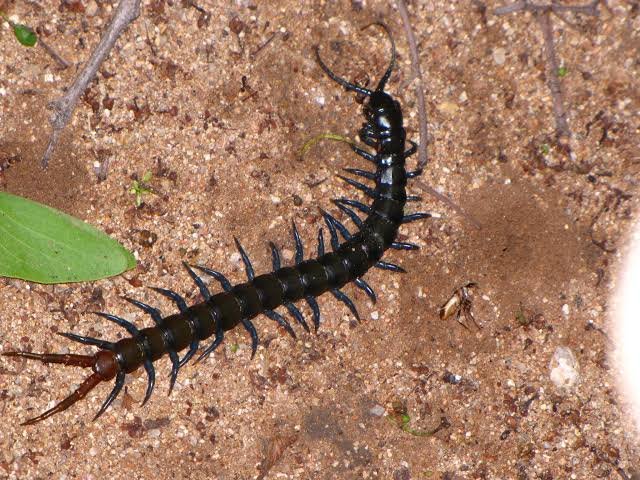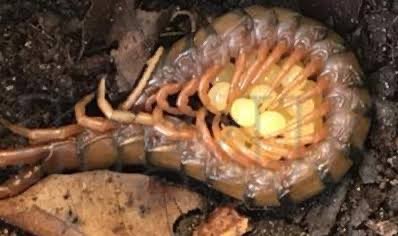Ethmostigmus trigonopodus—The African Giant Centipede.
Whoaaaaa, I screamed my lungs out! Something had climbed me that night, this was no cockroach, it felt heavier and was faster. I turned around, pointing my phone's torchlight around, but could not find anything. "Could it have really been a cockroach? Cockroaches are fast nocturnal insects" But I just could not bring myself to go back to sleep as I had this nagging feeling that whatever it was that crawled past me wasn't just a cockroach.
The rains had refused to come and the temperature was high with an insanely hot air circulating in the house that night. So I decided to lie on the bare floor to escape the heat.

As I was about turning off the lights, I saw it! It was black, long, had several tiny legs and moved with the speed of light, in a snake-like motion. "Yes! That was what climbed over me".
Frightened that it could be something poisonous, I took a leg of my crocs and hit it so hard, but…Its skin was as tough as an uncooked meat. Despite several hits, It still wiggled on! What was that?!! It was the African Giant Centipede, scientifically known as Ethmostigmus trigonopodus. I have not seen anything like that in my life before, and was curious as to what it was, so I began my research.
Now let us get down to the interesting part!
Ethmostigmus trigonopodus originates from Niger in Africa, it is commonly dark brown or black in colour, about eight inches long, from the Scolopendridae family—In the Scolopendridae family includes some of the most venomous and the largest centipedes. Its body is segmented with long antennas used in detecting movements and catching preys, it’s extremely fast due to its multiple legs.
These Arthropods thrive better in moist environments, their exoskeletal structure makes it difficult for them to adapt to extreme dry areas as they are prone to dehydration. So whenever the climate is dry, they burrow deep underground.
We cannot talk about any insects, mammals, anthropods etc without discussing its reproduction process. This part amuses me, the African Giant Centipede reproduces through a process where male deposits sperm in a silk covering called Spermatophore. The process involves the male depositing a packet of sperm and the female finding it and taking it up, as soon as the female picks up the spermatophore, it goes straight to her reproductive tracts and fertilizes her eggs.

The female then goes to a moist or damp area to lay her eggs. After the eggs are laid, she protects them (like human mothers)—she eats the eggs up if she feels the slightest vibration, this is her way of protecting her eggs from predators. It takes between a year and three years for the eggs to reach the adulthood stage, after several molt stages.
The Ethmostigmus trigonopodus is venomous and can cause in some cases, anaphylactic shock. When I researched up to this stage, I became even more scared…What if it had bitten me the night before or anyone else for that matter?
Although they require special care but people keep them as pets which help control insects in the ecosystem, also them being able to burrow into the ground helps degrade decaying organic matters which enriches the soil. I’m capturing it and taking it to a laboratory when next I see it, it’s an interesting insect.
References
https://www.inaturalist.org/taxa/1061036-Ethmostigmus-trigonopodus
https://www.inaturalist.org/taxa/1061036-Ethmostigmus-trigonopodus/browse_photos
https://smallexoticfarm.ie/product/giant-african-centipede-ethmostigmus-trigonopodus-niger/
https://www.exotic-pets.co.uk/african-giant-centipede.html
https://wiki.hoodedhorse.com/Empires_of_the_Undergrowth/African_Giant_Centipede
https://crevicedwelling.tumblr.com/post/715778666415702016/an-african-giant-centipede-ethmostigmus
Thank you very much for your continuous support 🙏
EEEEEEEEEEEK!!!!! I would also be freaking out if that thing decided to occupy the same space as me! We actually have a tarantula at home called Harry... (We used to have two but Rosetta passed away last year) and you know what, I'm fine as long as he stays in his cage and I don't have to touch or feed or get involved with anything to do with him or his food (which are cockroaches, vegan fruit ones, but still eww)!
You keep them as pets? That's really interesting but eewww.. 😁
@zakludick and @merenludick do. I have nothing to do with them. Lol. Well, we only have Harry left since Rosetta passed last year, so I guess it's not "them" it's just him, which is surprisingly very sad to me.
Well done! You have been manually curated by @clairemobey for the 😉🐝😉🐝Busy Bees Manual Curation Report #02😉🐝😉🐝
keep beeeeeeing awesome and show some love to the other @busybees by upvoting, commenting on and reblogging their content!
Thank you very much 🙏
Thank you so much for tis fascinating post! I actually thought all lady bugs were carnivorous, so I learned something new!
You are welcome.
!Hug